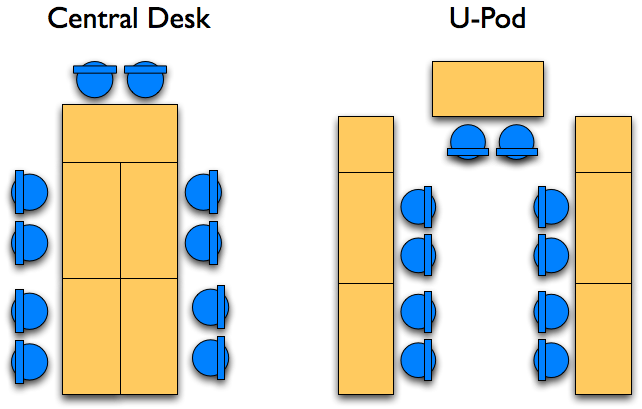My "instant runoff vote" would be to order the options thusly: 5, 4, 1, 2a, 2b
I don't think 3 is really viable because of Criteria #2.
https://app.asana.com/0/62830781673321/62830781673321?
[--- Commented from Asana.com
commenter Jeffrey Wescott
---[aa]

laptops/pairing stations?
Criteria 1: every learner should have her own keyboard and pointer device
Criteria 2: more privileged students shouldn't have a better experience / learning advantage
Criteria 3: whatever environment a learner is using to learn (e.g., in-person pairing, remote pairing) should be optimized to keep learner focused on task at hand
Option 1: 2 laptops, pairing happens on one learner laptop, 2nd laptop is used for google searches, docs, etc. ($$)
pros: seamless interactions, forces attention on pairing cons: requires bluetooth reconfiguration every time we switch pairs (or else wired devices and at least 2 USB ports)
Option 2a: 2 laptops, pairing happens via software (a la Floobits); each learner has own monitor and laptop for screen real estate, but controls own machine and only syncrhonizes for pairing as necessary ($$)
pros: laptop provides keyboard and pointer device cons: easier for students to get distracted since keyboards / pointers aren't affecting each other
Option 2b: 2 laptops, pairing happens via software (a la ScreenHero); each learner has own monitor and laptop for screen real estate, but controls own machine and only synchronizes for pairing as necessary ($$)
pros: laptop provides keyboard and pointer device cons: easier for students to get distracted since keyboards / pointers aren't affecting each other; clunky pixel-sharing sub-optimal for pairing
Option 3: separate pairing stations, no laptops ($)
pros: less expensive than buying 1 laptop per student cons: students can't work independently unless they're rich enough for their own laptop; causes a sorting based on privilege
Option 4: pairing stations for full pod (12x monitors, 6x machines, 12x keyboards, 12x pointers) plus 1 laptop per learner ($$$$)
pros: best of all worlds cons: more expensive
Option 5: in a pod of 12, assume 6 "free" monitors, 3 pairing stations (3 machines, 6 monitors, 6 keyboards, 6 pointers), and 12 laptops; students can be on a pairing station together or working independently with extra screen real estate, or pairing via software ($$$)
pros: allows for us to observe learner behavior with respect to how they like to work and optimize the environment on an ongoing basis cons: more expensive
Recommendation: Option 5 (depending on budget)